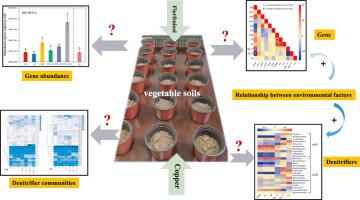Ecotoxicology and Environmental Safety ( IF 6.2 ) Pub Date : 2021-02-13 , DOI: 10.1016/j.ecoenv.2021.112011 Mei Wang , Jing Wu , Tong Zhou , Yi Liang , Lixuan Zheng , Yongxue Sun

|
Denitrification play an important role in nitrogen cycle and is affected by veterinary drugs entering agricultural soils. In the present study, the effects of copper and florfenicol on denitrification, related antibiotic resistance and environmental variables were characterized using real-time quantitative PCR (qPCR) and amplicon sequencing in a short-term (30 d) soil model experiment. Drug additions significantly decreased the nirS gene abundance (P < 0.05) but maximized the abundance of gene nirK in soil containing florfenicol and moderate copper levels (150 mg kg−1). Surprisingly, copper additions decreased the fexB gene abundance, however, the abundance of gene pcoD significantly increased in soils containing florfenicol, moderate copper levels (150 mg kg−1), and florfenicol and low copper levels (30 mg kg−1), respectively (P < 0.05). Overall, the nirK-type community composition was more complex than that of nirS-type but Proteobacteria predominated (> 90%) in both communities. Correlation analysis indicated that the gene abundance of fexB was highly correlated with NH4+-N (P < 0.05) and NO3--N (P < -0.01), and floR gene abundance was positively correlated with nirK (P < 0.01). Besides, the abundance of nirS-type genera Bradyrhizobium and Pseudomonas were obviously related to total organic matter (TOM), total nitrogen (TN) or total phosphorus (TP) (P < 0.05), while the abundance of nirK-type Rhizobium, Sphingomonas and Bosea showed a significantly correlated with TOM, TN or copper contents (P < 0.05). Taken together, copper and florfenicol contamination increased the possibility of durg resistance genes spread in agricultural soils through nitrogen transformation.
中文翻译:

铜和氟苯尼考对蔬菜土壤中nirS和nirK型反硝化菌群落及相关抗生素抗性的影响
反硝化在氮循环中起重要作用,并受到进入农业土壤的兽药的影响。在本研究中,使用实时定量PCR(qPCR)和扩增子测序在短期(30 d)土壤模型实验中表征了铜和氟苯尼考对反硝化作用,相关抗生素抗性和环境变量的影响。药物添加显着降低了nirS基因的丰度(P <0.05),但使含有氟苯尼考和中等铜含量(150 mg kg -1)的土壤中的nirK基因的丰度最大化。令人惊讶的是,铜的添加降低了fexB基因的丰度,但是,基因pcoD的丰度降低了分别在含有氟苯尼考,中等铜含量(150 mg kg -1)和氟苯尼考和低铜含量(30 mg kg -1)的土壤中显着增加(P <0.05)。总体而言,nirK型群落组成比nirS型更为复杂,但在这两个群落中,以细菌杆菌为主(> 90%)。相关性分析表明,fexB的基因丰度与NH 4 + -N(P <0.05)和NO 3 -- N(P <-0.01)高度相关,而floR基因的丰度与NH 4 + -N(P <-0.01)高度相关。nirK(P <0.01)。此外,nirS型根瘤菌和假单胞菌的丰度与总有机质(TOM),总氮(TN)或总磷(TP)明显相关(P <0.05),而nirK型根瘤菌,鞘氨醇单胞菌的丰富度和氧化包西氏显示出与TOM,TN或铜的内容的显著相关(P <0.05)。总之,铜和氟苯尼考的污染增加了通过氮转化在农业土壤中传播抗性基因的可能性。











































 京公网安备 11010802027423号
京公网安备 11010802027423号